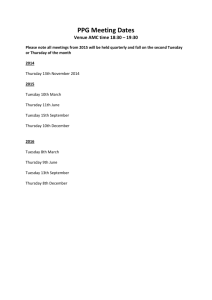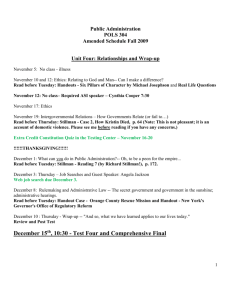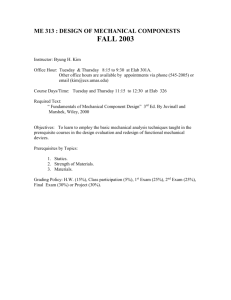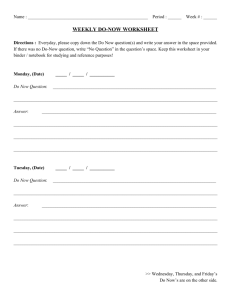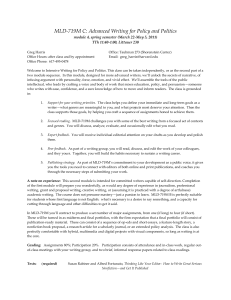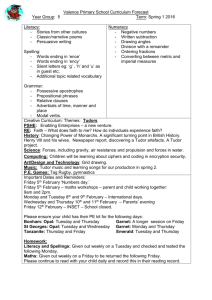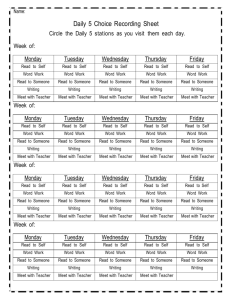3914
advertisement
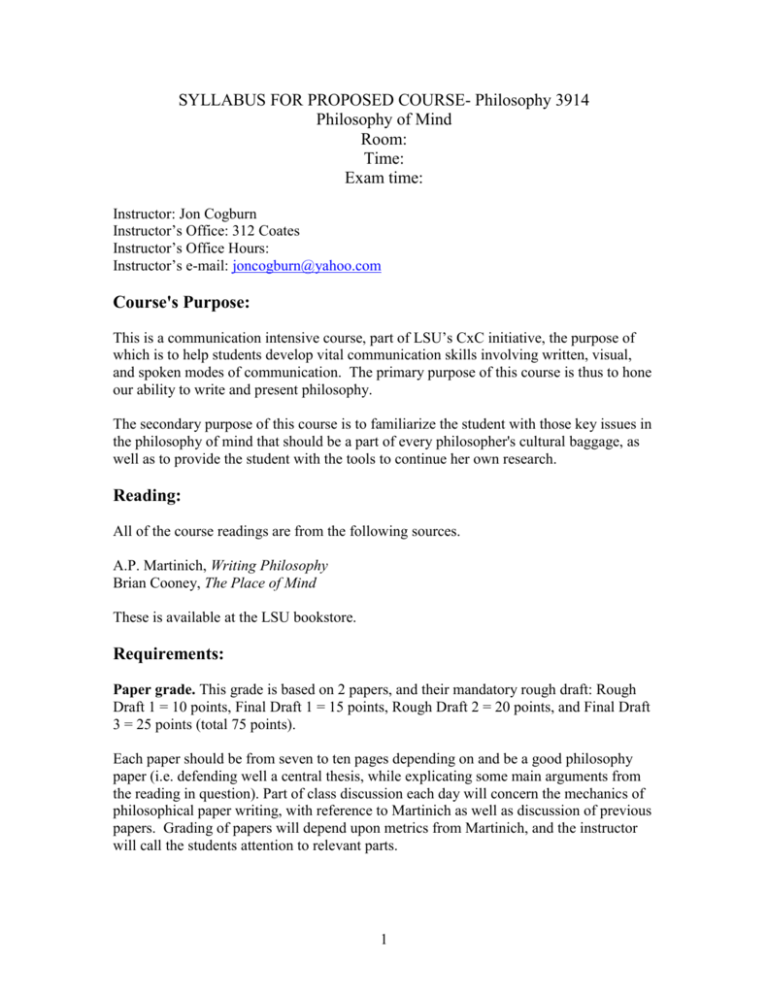
SYLLABUS FOR PROPOSED COURSE- Philosophy 3914 Philosophy of Mind Room: Time: Exam time: Instructor: Jon Cogburn Instructor’s Office: 312 Coates Instructor’s Office Hours: Instructor’s e-mail: joncogburn@yahoo.com Course's Purpose: This is a communication intensive course, part of LSU’s CxC initiative, the purpose of which is to help students develop vital communication skills involving written, visual, and spoken modes of communication. The primary purpose of this course is thus to hone our ability to write and present philosophy. The secondary purpose of this course is to familiarize the student with those key issues in the philosophy of mind that should be a part of every philosopher's cultural baggage, as well as to provide the student with the tools to continue her own research. Reading: All of the course readings are from the following sources. A.P. Martinich, Writing Philosophy Brian Cooney, The Place of Mind These is available at the LSU bookstore. Requirements: Paper grade. This grade is based on 2 papers, and their mandatory rough draft: Rough Draft 1 = 10 points, Final Draft 1 = 15 points, Rough Draft 2 = 20 points, and Final Draft 3 = 25 points (total 75 points). Each paper should be from seven to ten pages depending on and be a good philosophy paper (i.e. defending well a central thesis, while explicating some main arguments from the reading in question). Part of class discussion each day will concern the mechanics of philosophical paper writing, with reference to Martinich as well as discussion of previous papers. Grading of papers will depend upon metrics from Martinich, and the instructor will call the students attention to relevant parts. 1 NOTE: With student permission, the professor will share exceptional papers with the class via overhead projection. All papers must fulfill a number of formatting requirements: (1) They must be left justified with one inch margins, (2) they must be typed in 12 point Times or 12 point Times-Roman font, (3) page numbers must be centered at the bottom of the page, (4) papers must be double spaced (with the exception of cited material which is indented), (5) papers must be printed out with either an ink jet or laser printer, (6) papers must be stapled together (do not use binders or folders of any sort), and (7) student's name, the date, and the time her course meets must be at the top right hand corner of the first page. Any deviation from these requirements will result in the student having to turn in the paper correctly formatted and late. Presentation and Journal STEP 1- Each student will pair with one other student to present the main arguments of an article. Each student will talk for fifteen minutes about her or his part of the article. Each student will prepare a separate handout explicitly stating the arguments to be discussed, and any counterarguments considered by the student in his or her presentation (see Martinich). Each handout must state very clearly the date of the original presentation and the name of the relevant article. The student is in charge of photocopying 35 copies of his or her handout to distribute to the other students. Students will work together to make sure that they do not discuss the same arguments. Each paper we read will have so many non-trivial arguments, that this will not be an issue. Articles will be assigned by the end of week 2. Presentation will be at the beginning of the class. Then in the remaining fifty minutes, the professor will lead discussion. We will first (circa twenty minutes) informally discuss how the presentation could have been better. Students in the class will suggest ways that the handouts could be improved, and the presenters will take notes and discuss this. Then in one weeks time the presenters will distribute rewritten handouts, improved based on the informal discussion. Then we will (circa thirty minutes) have an openended discussion, again led by the professor, of any relevant philosophical issues. It cannot be emphasized enough that both discussions are opportunities for learning both philosophy and how to improved communication. STEP 2- Each student is required to write a short (one quarter to one page) typed response to the handouts from the previous day’s lecture. The student is to make three copies of each response, one copy for her journal, one copy for the professor, and one copy to be given in the next class period to the presenter in question. Each response must state very clearly in the top right hand corner of the paper, the date of the original presentation and the name of the relevant article. STEP 3- The presenters will rewrite their handouts, improving them based on verbal and written responses from the students and professor. Then they will photocopy their handouts (35 copies) and distribute the photocopies to the class. Each handout must state 2 very clearly in the top right hand corner of the paper, the date of the original presentation and the name of the relevant article. Student journals will consist of three sections: (1) each original (non-corrected) handout given, plus that student’s comments on that handout, (2) the original handout made for that student’s presentation, followed by all of the comments received, and that student’s final handout, and (3) all of the final handouts. Note: the instructor is not responsible for getting handouts to students! Students are responsible for contacting presenters and keeping up to date. Journal and presentation grades will be 25% of the course grade. The most important part of this grade will be determined by how the students make a good faith effort to improve their own handouts, and to help other students with their handouts. Office Hour Policy: Students are strongly recommended to make use of the instructor's office hours throughout the semester. Ethical and Professional Responsibility: Acceptable projects must be the personal work of the communicator and thus may not include in any form work of another person without giving appropriate and full credit. Campus Help: Students are strongly encouraged to avail themselves to the excellent LSU communication resources. Please go to the CxC website at http://appl003.lsu.edu/acadaff/CxC.nsf/index . Tentative Schedule: Note: Numbers refer to sections in the book. Week 1 Tuesday, Jan. 18 Part I Cartesian Dualism Thursday, Jan. 20 1 Part II The Ghost in the Machine Week 2 Tuesday, Jan. 25 3 2 Thursday, Jan. 27 3 Part III The Human Brain Week 3 Tuesday, Feb. 1 4 Part IV Materialism A The Identity Thesis Thursday, Feb. 3 5 Week 4 Tuesday, Feb. 8 Mardis Gras Holiday--No class Thursday, Feb. 10 6 Week 5 Tuesday, Feb. 15 7 B Eliminative Materialism Thursday, Feb. 17 8&9 C Functionalism Week 6 Tuesday, Feb. 22 10 Thursday, Feb. 24 11 rough draft of paper 1 due Week 7 Tuesday, Mar. 1 12 Thursday, Mar. 3 13 Part V Minds and Computers Week 8 Mid-Semester exams Tuesday, Mar. 8 final version of paper 1 due 14 4 Thursday, Mar. 10 15 Week 9 Midsemester grades due Mar. 15 Tuesday, Mar. 15 16 Thursday, Mar. 17 17 Week 10 Tuesday, March 22 Thursday, March 24 Spring Break, No Classes Week 11 Tuesday, March 29 18 Part VII Consciousness and Qualia Thursday, March 31 22 Week 12 Tuesday, Apr. 5 23 Thursday, Apr. 7 24 Week 13 Tuesday, Apr. 12 25 Thursday, Apr. 14 26 Week 14 Tuesday, Apr. 19 27 Thursday, Apr. 21 28 rough draft of paper 2 due Part V VIII SELVES Week 15 Tuesday, Apr. 26 31 Thursday, Apr. 28 32 Week 16 5 Tuesday, May 3 33 Thursday, May 5 34 Week 17--Final Exam Period Tuesday, May 10, 5:30-7:30 P.M. final version of paper 2 due, final journals due 6
